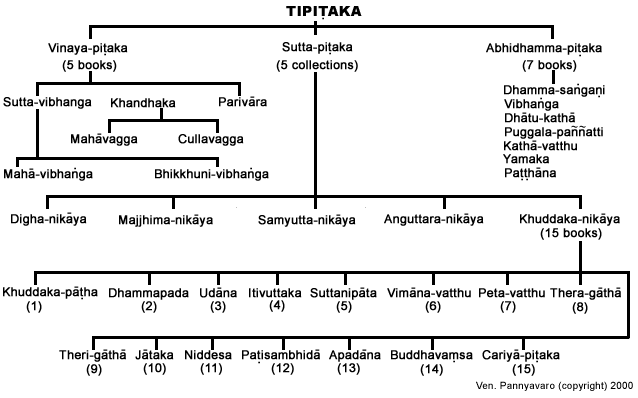|
Welcome to Dhammapada In Tamil
This book is published by BPS, and you can contact them to obtain a hard copy. BPS Tel: 081 2237283 Tel/Fax: 081 2233679 |
Mr.M.N.Mohideen |
29) Classical English,99) Classical Tamil-பாரம்பரிய இசைத்தமிழ் செம்மொழி,100) Classical Telugu- క్లాసికల్ తెలుగు,55) Classical Kannada- ಶಾಸ್ತ್ರೀಯ ಕನ್ನಡ,69) Classical Malayalam-ക്ലാസിക്കൽ മലയാളം,72) Classical Marathi-क्लासिकल माओरी,45) Classical Hindi- शास्त्रीय हिंदी,16) Classical Bengali-ক্লাসিক্যাল বাংলা,72) Classical Marathi-क्लासिकल माओरी,45) Classical Hindi- शास्त्रीय हिंदी,40) Classical Gujarati-ક્લાસિકલ ગુજરાતી,74) Classical Myanmar (Burmese)-Classical မြန်မာ (ဗမာ),75) Classical Nepali-शास्त्रीय म्यांमार (बर्मा),81) Classical Punjabi-ਕਲਾਸੀਕਲ ਪੰਜਾਬੀ, 89) Classical Sindhi,90) Classical Sinhala-සම්භාව්ය සිංහල, 104) Classical Urdu- کلاسیکی ارد
106) Classical Vietnamese-Tiếng Việt cổ điển,
29) Classical English,99) Classical Tamil-பாரம்பரிய இசைத்தமிழ் செம்மொழி,100) Classical Telugu- క్లాసికల్ తెలుగు,55) Classical Kannada- ಶಾಸ್ತ್ರೀಯ ಕನ್ನಡ,69) Classical Malayalam-ക്ലാസിക്കൽ മലയാളം,72) Classical Marathi-क्लासिकल माओरी,45) Classical Hindi- शास्त्रीय हिंदी,16) Classical Bengali-ক্লাসিক্যাল বাংলা,72) Classical Marathi-क्लासिकल माओरी,45) Classical Hindi- शास्त्रीय हिंदी,40) Classical Gujarati-ક્લાસિકલ ગુજરાતી,74) Classical Myanmar (Burmese)-Classical မြန်မာ (ဗမာ),75) Classical Nepali-शास्त्रीय म्यांमार (बर्मा),81) Classical Punjabi-ਕਲਾਸੀਕਲ ਪੰਜਾਬੀ, 89) Classical Sindhi,90) Classical Sinhala-සම්භාව්ය සිංහල, 104) Classical Urdu- کلاسیکی ارد
Do Good Be Mindful - Awakened One with Awareness (AOA)
99) Classical Tamil-பாரம்பரிய இசைத்தமிழ் செம்மொழி,
நல்லது செய் கவனமாக இருங்கள்
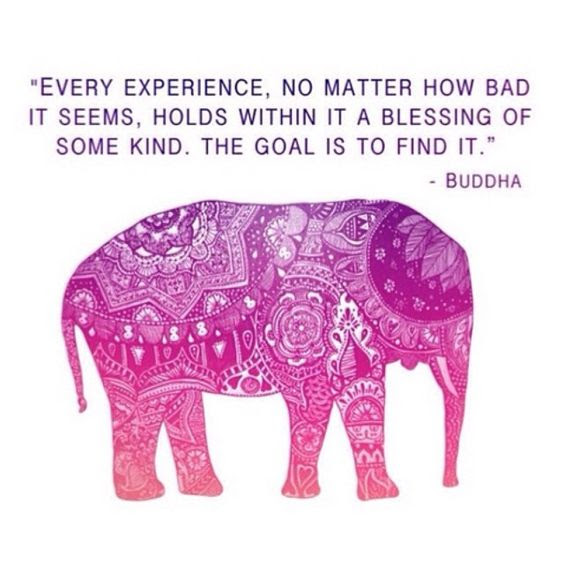
https://ayyothidhasapandithar.blogspot.com/2011/02/blog- post.html?showComment= 1543321731309# c4393403665995714293
55) Classical Kannada- ಶಾಸ್ತ್ರೀಯ ಕನ್ನಡ,
ಒಳ್ಳೆಯದನ್ನು ಮಾಡು ಜಾಗರೂಕರಾಗಿರಿ

https://in.pinterest.com/pin/770326711238077611/
69) Classical Malayalam-ക്ലാസിക്കൽ മലയാളം,

https://in.pinterest.com/pin/297237644143575195/
72) Classical Marathi-क्लासिकल माओरी,

https://in.pinterest.com/pin/477240891749063355/
45) Classical Hindi- शास्त्रीय हिंदी,

https://in.pinterest.com/pin/253327547769516740/
16) Classical Bengali-ক্লাসিক্যাল বাংলা,
ভাল কর মনোযোগী হও

https://in.pinterest.com/pin/546554104770260342/
40) Classical Gujarati-ક્લાસિકલ ગુજરાતી,
સારું કરો માઇન્ડફુલ રહો

74) Classical Myanmar (Burmese)-Classical မြန်မာ (ဗမာ),
ကောင်းမွန်သောလုပ်ပါ စိတ်ကို Be
https://in.pinterest.com/pin/537195061797320216/
https://in.pinterest.com/pin/537195061797320216/
74) Classical Myanmar (Burmese)-Classical မြန်မာ (ဗမာ),
ကောင်းမွန်သောလုပ်ပါ စိတ်ကို Be
answering these questions you will discover your unique passions,
strengths, values, desires, and motivations, which are all yearning for
your…
75) Classical Nepali-शास्त्रीय म्यांमार (बर्मा),
राम्रो गर्नुहोस् Mindful हुनुहोस्
https://in.pinterest.com/pin/534802524499894866/
75) Classical Nepali-शास्त्रीय म्यांमार (बर्मा),
राम्रो गर्नुहोस् Mindful हुनुहोस्
81) Classical Punjabi-ਕਲਾਸੀਕਲ ਪੰਜਾਬੀ,
ਚੰਗਾ ਕਰੋ ਧਿਆਨ ਰੱਖੋ
https://in.pinterest.com/pin/346777240056608696/
81) Classical Punjabi-ਕਲਾਸੀਕਲ ਪੰਜਾਬੀ,
ਚੰਗਾ ਕਰੋ ਧਿਆਨ ਰੱਖੋ
| Pinterest | Quotes, Inspirational…
89) Classical Sindhi,
سٺو ڪريو دلبر ٿي وڃي
https://in.pinterest.com/pin/87679523981813903/
89) Classical Sindhi,
سٺو ڪريو دلبر ٿي وڃي
90) Classical Sinhala-සම්භාව්ය සිංහල,
හොඳ දේවල් කරන්න මතක තබාගන්න
https://in.pinterest.com/pin/632192866420520646/
90) Classical Sinhala-සම්භාව්ය සිංහල,
හොඳ දේවල් කරන්න මතක තබාගන්න
101) Classical Thai-ภาษาไทยคลาสสิก,
ทำดี จงระวังตัว
https://in.pinterest.com/pin/520939881895738192/
101) Classical Thai-ภาษาไทยคลาสสิก,
ทำดี จงระวังตัว
104) Classical Urdu- کلاسیکی اردو
متسی ہاچھا کروو
https://in.pinterest.com/pin/805792558306141468/
104) Classical Urdu- کلاسیکی اردو
متسی ہاچھا کروو
106) Classical Vietnamese-Tiếng Việt cổ điển,

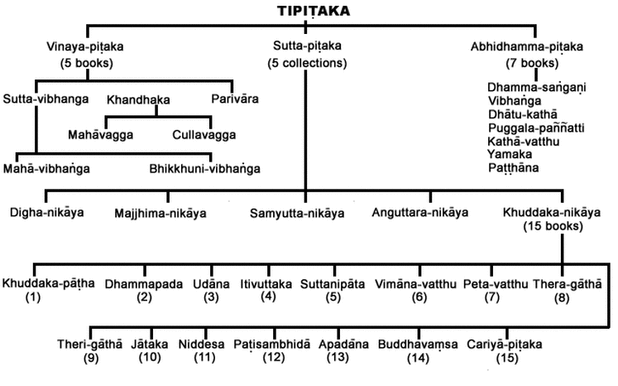
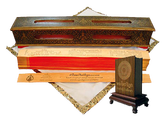
Vinay Pitak
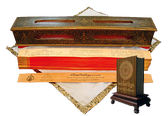
Abhidhamma Pitak






https://www.omniglot.com/writing/pali.htm
Pāli (पालि)
Pāli is the language of the scriptures of Theravada Buddhism,
(the Pāli Canon or the Tipitaka in Pāli), which
were written in Sri Lanka during the 1st century BC. Pāli has been
written in a variety of scripts, including Brahmi,
Devanāgarī and other Indic scripts,
and also using a version of the Latin alphabet devised by T. W. Rhys Davids of
the Pāli Text Society.
The name Pāli means “line” or “(canonical) text”, and probably comes
from the commentarial traditions, wherein the “Pāli” (in the sense of
the line of original text quoted) was distinguished from the commentary or
the vernacular following after it on the manuscript page. There are a number
of ways to spell the name of the language: Pali, Pāli, Paḷi,
Pāḷi, all four of which are found in textbooks.
Today Pāli is studied mainly by those who wish to read the original
Buddhist scriptures, and is frequently chanted in rituals. There are non-religious
text in Pāli including historical and medical texts. The main areas where
Pāli is studied are Myanmar, Sri Lanka, Thailand, Laos and Cambodia.
Devanāgarī alphabet for Pāli



Vinay Pitak

Abhidhamma Pitak






https://www.omniglot.com/writing/pali.htm
Pāli (पालि)
Pāli is the language of the scriptures of Theravada Buddhism,
(the Pāli Canon or the Tipitaka in Pāli), which
were written in Sri Lanka during the 1st century BC. Pāli has been
written in a variety of scripts, including Brahmi,
Devanāgarī and other Indic scripts,
and also using a version of the Latin alphabet devised by T. W. Rhys Davids of
the Pāli Text Society.
The name Pāli means “line” or “(canonical) text”, and probably comes
from the commentarial traditions, wherein the “Pāli” (in the sense of
the line of original text quoted) was distinguished from the commentary or
the vernacular following after it on the manuscript page. There are a number
of ways to spell the name of the language: Pali, Pāli, Paḷi,
Pāḷi, all four of which are found in textbooks.
Today Pāli is studied mainly by those who wish to read the original
Buddhist scriptures, and is frequently chanted in rituals. There are non-religious
text in Pāli including historical and medical texts. The main areas where
Pāli is studied are Myanmar, Sri Lanka, Thailand, Laos and Cambodia.


Vinay Pitak

Abhidhamma Pitak

Vinay Pitak

Abhidhamma Pitak






https://www.omniglot.com/writing/pali.htm
Pāli (पालि)
Pāli is the language of the scriptures of Theravada Buddhism,
(the Pāli Canon or the Tipitaka in Pāli), which
were written in Sri Lanka during the 1st century BC. Pāli has been
written in a variety of scripts, including Brahmi,
Devanāgarī and other Indic scripts,
and also using a version of the Latin alphabet devised by T. W. Rhys Davids of
the Pāli Text Society.
The name Pāli means “line” or “(canonical) text”, and probably comes
from the commentarial traditions, wherein the “Pāli” (in the sense of
the line of original text quoted) was distinguished from the commentary or
the vernacular following after it on the manuscript page. There are a number
of ways to spell the name of the language: Pali, Pāli, Paḷi,
Pāḷi, all four of which are found in textbooks.
Today Pāli is studied mainly by those who wish to read the original
Buddhist scriptures, and is frequently chanted in rituals. There are non-religious
text in Pāli including historical and medical texts. The main areas where
Pāli is studied are Myanmar, Sri Lanka, Thailand, Laos and Cambodia.
Pāli (पालि)
Pāli is the language of the scriptures of Theravada Buddhism,
(the Pāli Canon or the Tipitaka in Pāli), which
were written in Sri Lanka during the 1st century BC. Pāli has been
written in a variety of scripts, including Brahmi,
Devanāgarī and other Indic scripts,
and also using a version of the Latin alphabet devised by T. W. Rhys Davids of
the Pāli Text Society.
The name Pāli means “line” or “(canonical) text”, and probably comes
from the commentarial traditions, wherein the “Pāli” (in the sense of
the line of original text quoted) was distinguished from the commentary or
the vernacular following after it on the manuscript page. There are a number
of ways to spell the name of the language: Pali, Pāli, Paḷi,
Pāḷi, all four of which are found in textbooks.
Today Pāli is studied mainly by those who wish to read the original
Buddhist scriptures, and is frequently chanted in rituals. There are non-religious
text in Pāli including historical and medical texts. The main areas where
Pāli is studied are Myanmar, Sri Lanka, Thailand, Laos and Cambodia.
Pāli (पालि)
(the Pāli Canon or the Tipitaka in Pāli), which
were written in Sri Lanka during the 1st century BC. Pāli has been
written in a variety of scripts, including Brahmi,
Devanāgarī and other Indic scripts,
and also using a version of the Latin alphabet devised by T. W. Rhys Davids of
the Pāli Text Society.
from the commentarial traditions, wherein the “Pāli” (in the sense of
the line of original text quoted) was distinguished from the commentary or
the vernacular following after it on the manuscript page. There are a number
of ways to spell the name of the language: Pali, Pāli, Paḷi,
Pāḷi, all four of which are found in textbooks.
Buddhist scriptures, and is frequently chanted in rituals. There are non-religious
text in Pāli including historical and medical texts. The main areas where
Pāli is studied are Myanmar, Sri Lanka, Thailand, Laos and Cambodia.
Devanāgarī alphabet for Pāli

Sample text in Pāli (Romanized script)
Appam pi ce saṃhitaṃ bhāsamāno dhammassa
hoti anudhammacārī, rāgañ ca dosañ
ca pahāya mohaṃ sammāppajāno suvimuttacitto,
anupādiyāno idha vā huraṃ vā sa
bhāgavā sāmaññassa hoti.
Translation
Even if he recites a little of scriptures, but lives in truth according
to the Dharma, having abandoned lust, hatred and delusion, has the right
knowledge, with a well emancipated mind, is not attached to anything, either
in this world, nor in the other one, he shares the [blessings of] monkshood.
(Source: of Digital Library & Museum of Buddhist studies)
http://skyknowledge.com/akkharamuni.htm
Akkhara Muni
Ian James
© January 2010, November 2011

This is an experimental script for Pali, the ecclesiastical language of Buddhism.
Pali is normally written in the Sinhala, Khmer, Burmese, Devanagari,
Lao or Thai scripts, or with the Latin alphabet using diacritics.
This script has a Classical serif font style,
with shapes based on those of ancient Brahmi and Pallava,
which were the ancestors of the Indic scripts just mentioned.
It aims at a unified, linear effect, without complicated
vowel placement or diacritics. The name means Letters of the Sage.
Consonants
Most letters are quite easily recognizable from their counterparts in other Indic scripts.
As with almost all Indic scripts, and different from Ariyaka,
consonants have an inherent short /a/ if no vowel letter is written.
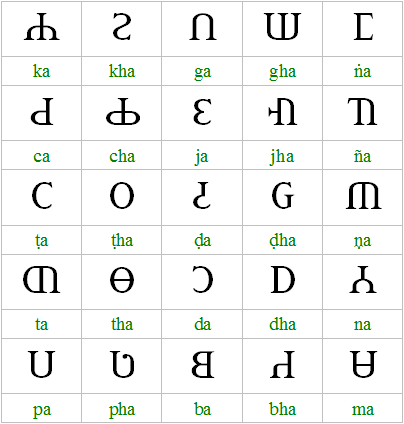

The glottal plosive acts as a prefix for initial vowels, as is found in many Indic scripts.
The two extra /s/ glyphs are for Sanskrit words. The dotted /m/ suffix is a vowel nasalizer,
being a common Pali morpheme. It may be noted the retroflex laterals are not encoded;
they are considered allophones of the retroflex plosives, emerging in speech when between vowels.
Vowels
The written vowels follow their consonants in all cases,
in a linear, single-channel manner; this is unlike most Indic scripts,
whose vowels end up all over the place. The /ai/ and /au/ glyphs are for Sanskrit words.
A “no vowel” mark may be used to cancel the inherent short /a/,
as is required for consonants which close a syllable.

Punctuation etc
The “no vowel between” mark is for non-final, cluster or sandhi situations
where the consonants run together. Where a consonant is doubled, a colon-shape is used in place of the
second component. Note that where an aspirated consonant is doubled, an unaspirated form arises as the first
component of the gemination; in Akkhara Muni, only the aspirated consonant is written, and any loss
of aspiration due to doubling is ignored in writing.

Please note that Akkhara Muni seeks to capture the phonetics of the language,
and not duplicate existing systems of spelling. Even so, some further work may be required to
deal with all phonological conditions adequately, and/or simplify common morphological situations.
Examples
These are based on my own poor reading of the Romanized Pali, and so may not perfectly reflect the
classical pronunciation. Ideally, we will want to read and hear something close to what the Buddha
himself might have said.
1. This is the first verse of the Dhammapada.


“Mind precedes all mental states, mind is their chief, they are all mind-wrought.
If a person speaks or acts with an impure mind,
Suffering follows him like the wheel follows the foot of the ox.”
2. This is the 154th verse of the Dhammapada.

“Oh house-builder! You are seen, you shall build no house (for me) again.
All your rafters are broken, your roof-tree is destroyed.
My mind has reached the unconditioned; the end of craving has been attained.”
A version of this page can also be found on
Omniglot.
See also:
Thai and Lao for writing Pali, and
the Ariyaka script created by King Rama IV of Siam.
https://www.youtube.com/results?search_query=+Pali+Alphabets+Saravamma+
Pali Alphabets Saravamma

Published on May 20, 2018
https://www.youtube.com/results…
OCBS Online Pali Course - Level 1: Lecture 04 (Pali Alphabet and Pronunciation)
Oxford Centre for Buddhist Studies
Published on May 20, 2018
This is lecture 04 from Level 1 of the OCBS Online Pali Course.
Dr Alexander Wynne guides you through the Pali Alphabet and explains how to pronounce the various letters.
See our website:
https://www.ocbs.org
See also our Facebook page:
https://www.facebook.com/OxfordOcbs
The OCBS is a Recognised Independent Centre of the University of Oxford.
Category
Education
youtube.com
Enjoy the videos and music you love, upload original content, and share it all with friends, family, and the world on YouTube.
https://www.youtube.com/watch?v=joWLbqYxX8o&t=199s
Learn Pali Grammar & Language - Basic Declension
https://www.youtube.com/watch?v=dt06sR8cabI&t=225s
Learn Pali Grammar & Language - Present Singular verbs
Learn Pali
Published on Jun 23, 2018
Pali grammar lessons for the absolute beginner in English. In his video
the idea of grammatical person is explored as well as subject - verb
agreement. The fifth video in this series of English Language Pali
tutorials.
Category
Education
youtube.com
Pali grammar lessons for the absolute beginner in English. In his video the idea of grammatical person is…
https://www.youtube.com/watch?v=DxpnRwEvqBU
Learn Pali Grammar & Language - Nominative & Accusative
Learn Pali
Published on Jun 18, 2018
Pali grammar lessons for the absolute beginner in English. This video
deals with the nominative and accusative cases and their subjective,
objective nature. The third video in this series of English Language
Pali tutorials.
Category
Education
youtube.com
Pali grammar lessons for the absolute beginner in English. This video deals with the nominative and…
https://www.youtube.com/watch?v=aVuecUjRzqM
Learn Pali
Published on Aug 27, 2018
Pali grammar lessons for the absolute beginner in English.. This video
explains the Pali case system and how nouns decline. This is the eighth
video in this series of Pali online tutorials. For more information
& pali learning resources check out my blog.
palistudies.blogspot.com
Category
Education
Learn Pali Grammar & Language - Pali noun cases & declension
youtube.com
Pali grammar lessons for the absolute beginner in English.. This video explains the Pali case system and…
Sangha
Dhammapada In Tamil
https://in.pinterest.com/pin/194288171407965404/
-
Sample text in Pāli (Romanized script)
Appam pi ce saṃhitaṃ bhāsamāno dhammassa
hoti anudhammacārī, rāgañ ca dosañ
ca pahāya mohaṃ sammāppajāno suvimuttacitto,
anupādiyāno idha vā huraṃ vā sa
bhāgavā sāmaññassa hoti.
Translation
Even if he recites a little of scriptures, but lives in truth according
to the Dharma, having abandoned lust, hatred and delusion, has the right
knowledge, with a well emancipated mind, is not attached to anything, either
in this world, nor in the other one, he shares the [blessings of] monkshood.
(Source: of Digital Library & Museum of Buddhist studies)
Sample text in Pāli (Romanized script)
Appam pi ce saṃhitaṃ bhāsamāno dhammassa
hoti anudhammacārī, rāgañ ca dosañ
ca pahāya mohaṃ sammāppajāno suvimuttacitto,
anupādiyāno idha vā huraṃ vā sa
bhāgavā sāmaññassa hoti.
Translation
to the Dharma, having abandoned lust, hatred and delusion, has the right
knowledge, with a well emancipated mind, is not attached to anything, either
in this world, nor in the other one, he shares the [blessings of] monkshood.
(Source: of Digital Library & Museum of Buddhist studies)
http://skyknowledge.com/akkharamuni.htm
Akkhara Muni
Ian James
© January 2010, November 2011

This is an experimental script for Pali, the ecclesiastical language of Buddhism.
Pali is normally written in the Sinhala, Khmer, Burmese, Devanagari,
Lao or Thai scripts, or with the Latin alphabet using diacritics.
This script has a Classical serif font style,
with shapes based on those of ancient Brahmi and Pallava,
which were the ancestors of the Indic scripts just mentioned.
It aims at a unified, linear effect, without complicated
vowel placement or diacritics. The name means Letters of the Sage.
Consonants
Most letters are quite easily recognizable from their counterparts in other Indic scripts.
As with almost all Indic scripts, and different from Ariyaka,
consonants have an inherent short /a/ if no vowel letter is written.


The glottal plosive acts as a prefix for initial vowels, as is found in many Indic scripts.
The two extra /s/ glyphs are for Sanskrit words. The dotted /m/ suffix is a vowel nasalizer,
being a common Pali morpheme. It may be noted the retroflex laterals are not encoded;
they are considered allophones of the retroflex plosives, emerging in speech when between vowels.
Vowels
The written vowels follow their consonants in all cases,
in a linear, single-channel manner; this is unlike most Indic scripts,
whose vowels end up all over the place. The /ai/ and /au/ glyphs are for Sanskrit words.
A “no vowel” mark may be used to cancel the inherent short /a/,
as is required for consonants which close a syllable.

Punctuation etc
The “no vowel between” mark is for non-final, cluster or sandhi situations
where the consonants run together. Where a consonant is doubled, a colon-shape is used in place of the
second component. Note that where an aspirated consonant is doubled, an unaspirated form arises as the first
component of the gemination; in Akkhara Muni, only the aspirated consonant is written, and any loss
of aspiration due to doubling is ignored in writing.

Please note that Akkhara Muni seeks to capture the phonetics of the language,
and not duplicate existing systems of spelling. Even so, some further work may be required to
deal with all phonological conditions adequately, and/or simplify common morphological situations.
Examples
These are based on my own poor reading of the Romanized Pali, and so may not perfectly reflect the
classical pronunciation. Ideally, we will want to read and hear something close to what the Buddha
himself might have said.
1. This is the first verse of the Dhammapada.


“Mind precedes all mental states, mind is their chief, they are all mind-wrought.
If a person speaks or acts with an impure mind,
Suffering follows him like the wheel follows the foot of the ox.”
2. This is the 154th verse of the Dhammapada.

“Oh house-builder! You are seen, you shall build no house (for me) again.
All your rafters are broken, your roof-tree is destroyed.
My mind has reached the unconditioned; the end of craving has been attained.”
A version of this page can also be found on
Omniglot.
See also:
Thai and Lao for writing Pali, and
the Ariyaka script created by King Rama IV of Siam.
https://www.youtube.com/results?search_query=+Pali+Alphabets+Saravamma+
Pali Alphabets Saravamma

Published on May 20, 2018
https://www.youtube.com/results…
OCBS Online Pali Course - Level 1: Lecture 04 (Pali Alphabet and Pronunciation)
Oxford Centre for Buddhist Studies
Published on May 20, 2018
This is lecture 04 from Level 1 of the OCBS Online Pali Course.
Dr Alexander Wynne guides you through the Pali Alphabet and explains how to pronounce the various letters.
See our website:
https://www.ocbs.org
See also our Facebook page:
https://www.facebook.com/OxfordOcbs
The OCBS is a Recognised Independent Centre of the University of Oxford.
Category
Education
youtube.com
Enjoy the videos and music you love, upload original content, and share it all with friends, family, and the world on YouTube.
https://www.youtube.com/watch?v=joWLbqYxX8o&t=199s
Learn Pali Grammar & Language - Basic Declension
https://www.youtube.com/watch?v=dt06sR8cabI&t=225s
Learn Pali Grammar & Language - Present Singular verbs
Learn Pali
Published on Jun 23, 2018
Pali grammar lessons for the absolute beginner in English. In his video
the idea of grammatical person is explored as well as subject - verb
agreement. The fifth video in this series of English Language Pali
tutorials.
Category
Education
youtube.com
Pali grammar lessons for the absolute beginner in English. In his video the idea of grammatical person is…
https://www.youtube.com/watch?v=DxpnRwEvqBU
Learn Pali Grammar & Language - Nominative & Accusative
Learn Pali
Published on Jun 18, 2018
Pali grammar lessons for the absolute beginner in English. This video
deals with the nominative and accusative cases and their subjective,
objective nature. The third video in this series of English Language
Pali tutorials.
Category
Education
youtube.com
Pali grammar lessons for the absolute beginner in English. This video deals with the nominative and…
https://www.youtube.com/watch?v=aVuecUjRzqM
Learn Pali
Published on Aug 27, 2018
Pali grammar lessons for the absolute beginner in English.. This video
explains the Pali case system and how nouns decline. This is the eighth
video in this series of Pali online tutorials. For more information
& pali learning resources check out my blog.
palistudies.blogspot.com
Category
Education
Learn Pali Grammar & Language - Pali noun cases & declension
youtube.com
Pali grammar lessons for the absolute beginner in English.. This video explains the Pali case system and…
Akkhara Muni
Ian James
© January 2010, November 2011
This is an experimental script for Pali, the ecclesiastical language of Buddhism.
Pali is normally written in the Sinhala, Khmer, Burmese, Devanagari,
Lao or Thai scripts, or with the Latin alphabet using diacritics.
This script has a Classical serif font style,
with shapes based on those of ancient Brahmi and Pallava,
which were the ancestors of the Indic scripts just mentioned.
It aims at a unified, linear effect, without complicated
vowel placement or diacritics. The name means Letters of the Sage.
Consonants
Most letters are quite easily recognizable from their counterparts in other Indic scripts.
As with almost all Indic scripts, and different from Ariyaka,
consonants have an inherent short /a/ if no vowel letter is written.
The glottal plosive acts as a prefix for initial vowels, as is found in many Indic scripts.
The two extra /s/ glyphs are for Sanskrit words. The dotted /m/ suffix is a vowel nasalizer,
being a common Pali morpheme. It may be noted the retroflex laterals are not encoded;
they are considered allophones of the retroflex plosives, emerging in speech when between vowels.
Vowels
The written vowels follow their consonants in all cases,
in a linear, single-channel manner; this is unlike most Indic scripts,
whose vowels end up all over the place. The /ai/ and /au/ glyphs are for Sanskrit words.
A “no vowel” mark may be used to cancel the inherent short /a/,
as is required for consonants which close a syllable.
Punctuation etc
The “no vowel between” mark is for non-final, cluster or sandhi situations
where the consonants run together. Where a consonant is doubled, a colon-shape is used in place of the
second component. Note that where an aspirated consonant is doubled, an unaspirated form arises as the first
component of the gemination; in Akkhara Muni, only the aspirated consonant is written, and any loss
of aspiration due to doubling is ignored in writing.
Please note that Akkhara Muni seeks to capture the phonetics of the language,
and not duplicate existing systems of spelling. Even so, some further work may be required to
deal with all phonological conditions adequately, and/or simplify common morphological situations.
Examples
These are based on my own poor reading of the Romanized Pali, and so may not perfectly reflect the
classical pronunciation. Ideally, we will want to read and hear something close to what the Buddha
himself might have said.
1. This is the first verse of the Dhammapada.
“Mind precedes all mental states, mind is their chief, they are all mind-wrought.
If a person speaks or acts with an impure mind,
Suffering follows him like the wheel follows the foot of the ox.”
2. This is the 154th verse of the Dhammapada.
“Oh house-builder! You are seen, you shall build no house (for me) again.
All your rafters are broken, your roof-tree is destroyed.
My mind has reached the unconditioned; the end of craving has been attained.”
A version of this page can also be found on
Omniglot.
See also:
Thai and Lao for writing Pali, and
the Ariyaka script created by King Rama IV of Siam.
https://www.youtube.com/results…
OCBS Online Pali Course - Level 1: Lecture 04 (Pali Alphabet and Pronunciation)
Oxford Centre for Buddhist Studies
Published on May 20, 2018
This is lecture 04 from Level 1 of the OCBS Online Pali Course.
Dr Alexander Wynne guides you through the Pali Alphabet and explains how to pronounce the various letters.
See our website:
https://www.ocbs.org
See also our Facebook page:
https://www.facebook.com/OxfordOcbs
The OCBS is a Recognised Independent Centre of the University of Oxford.
Category
Education
https://www.youtube.com/watch?v=dt06sR8cabI&t=225s
Learn Pali Grammar & Language - Present Singular verbs
Learn Pali
Published on Jun 23, 2018
Pali grammar lessons for the absolute beginner in English. In his video
the idea of grammatical person is explored as well as subject - verb
agreement. The fifth video in this series of English Language Pali
tutorials.
Category
Education
https://www.youtube.com/watch?v=DxpnRwEvqBU
Learn Pali Grammar & Language - Nominative & Accusative
Learn Pali
Published on Jun 18, 2018
Pali grammar lessons for the absolute beginner in English. This video
deals with the nominative and accusative cases and their subjective,
objective nature. The third video in this series of English Language
Pali tutorials.
Category
Education
https://www.youtube.com/watch?v=aVuecUjRzqM
Learn Pali
Published on Aug 27, 2018
Pali grammar lessons for the absolute beginner in English.. This video
explains the Pali case system and how nouns decline. This is the eighth
video in this series of Pali online tutorials. For more information
& pali learning resources check out my blog.
palistudies.blogspot.com
Category
Education
Learn Pali Grammar & Language - Pali noun cases & declension
Sangha
Dhammapada In Tamil
https://in.pinterest.com/pin/194288171407965404/
Dhammapada In Tamil
https://in.pinterest.com/pin/194288171407965404/
https://in.pinterest.com/pin/194288171407965404/


| The https://www.youtube.com/watch?v=_wwAnE65Ous&t=745s
Daily Buddhist Theravada Pali Chanting by VenVajiradhamma Thera Dhammalink One of the best Pali Buddhist Chanting. It is very peaceful, tranquil, pleasant and harmonious chanting.
This compilation
Website: www.dhammalink.com youtube.com
Daily Buddhist Theravada Pali Chanting by Venerable Vajiradhamma Thera One of the best Pali Buddhist…
https://www.youtube.com/watch?v=dCkULxhldtU&t=763s
Buddhist Chanting in Pali-Tisarana巴利文唱誦-三皈依 七宝佛教网络-净土讲堂Mypureland Published on Mar 30, 2012 巴利文唱誦-三皈依 youtube.com
巴利文唱誦-三皈依
https://www.youtube.com/watch?v=EtaP6DHawTQ&hd=1 for The Dhammapada (Sayings of the Buddha)- 1:24:40 hr
https://in.news.yahoo.com/robot-monk-blends-science-buddhism-chinese-temple-022046666.html
|
|||||||||||||
01) Classical Magahi Magadhi,
02) Classical Chandaso language,
03) Classical Magadhi Prakrit
04) Classical Pali
05) Classical Hela Basa
06) Classical Deva Nagari,
07) Classical Cyrillic
08) Classical Afrikaans– Klassieke Afrikaans
09) Classical Albanian-Shqiptare klasike,
10) Classical Amharic-አንጋፋዊ አማርኛ,
11) Classical Arabic-اللغة العربية الفصحى
12) Classical Armenian-դասական հայերեն,
13) Classical Azerbaijani- Klassik Azərbaycan,
14) Classical Basque- Euskal klasikoa,
15) Classical Belarusian-Класічная беларуская,
16) Classical Bengali-ক্লাসিক্যাল বাংলা,
17) Classical Bosnian-Klasični bosanski,
18) Classical Bulgaria- Класически българск,
19) Classical Catalan-Català clàssic
20) Classical Cebuano-Klase sa Sugbo,
21) Classical Chichewa-Chikale cha Chichewa,
22) Classical Chinese (Simplified)-古典中文(简体),
23) Classical Chinese (Traditional)-古典中文(繁體),
24) Classical Corsican-Corsa Corsicana,
25) Classical Croatian-Klasična hrvatska,
26) Classical Czech-Klasická čeština,
27) Classical Danish-Klassisk dansk,Klassisk dansk,
28) Classical Dutch- Klassiek Nederlands,
29) Classical English,
30) Classical Esperanto-Klasika Esperanto,
31) Classical Estonian- klassikaline eesti keel,
32) Classical Filipino,
33) Classical Finnish- Klassinen suomalainen,
34) Classical French- Français classique,
35) Classical Frisian- Klassike Frysk,
36) Classical Galician-Clásico galego,
37) Classical Georgian-კლასიკური ქართული,
38) Classical German- Klassisches Deutsch,
39) Classical Greek-Κλασσικά Ελληνικά,
40) Classical Gujarati-ક્લાસિકલ ગુજરાતી,
41) Classical Haitian Creole-Klasik kreyòl,
42) Classical Hausa-Hausa Hausa,
43) Classical Hawaiian-Hawaiian Hawaiian,
44) Classical Hebrew- עברית קלאסית
45) Classical Hindi- शास्त्रीय हिंदी,
46) Classical Hmong- Lus Hmoob,
47) Classical Hungarian-Klasszikus magyar,
48) Classical Icelandic-Klassísk íslensku,
49) Classical Igbo,
50) Classical Indonesian-Bahasa Indonesia Klasik,
51) Classical Irish-Indinéisis Clasaiceach,
52) Classical Italian-Italiano classico,
53) Classical Japanese-古典的なイタリア語,
54) Classical Javanese-Klasik Jawa,
55) Classical Kannada- ಶಾಸ್ತ್ರೀಯ ಕನ್ನಡ,
56) Classical Kazakh-Классикалық қазақ,
57) Classical Khmer- ខ្មែរបុរាណ,
58) Classical Korean-고전 한국어,
59) Classical Kurdish (Kurmanji)-Kurdî (Kurmancî),
60) Classical Kyrgyz-Классикалык Кыргыз,
61) Classical Lao-ຄລາສສິກລາວ,
62) Classical Latin-LXII) Classical Latin,
63) Classical Latvian-Klasiskā latviešu valoda,
64) Classical Lithuanian-Klasikinė lietuvių kalba,
65) Classical Luxembourgish-Klassesch Lëtzebuergesch,
66) Classical Macedonian-Класичен македонски,
67) Classical Malagasy,
68) Classical Malay-Melayu Klasik,
69) Classical Malayalam-ക്ലാസിക്കൽ മലയാളം,
70) Classical Maltese-Klassiku Malti,
71) Classical Maori-Maori Maori,
72) Classical Marathi-क्लासिकल माओरी,
73) Classical Mongolian-Сонгодог Монгол,
74) Classical Myanmar (Burmese)-Classical မြန်မာ (ဗမာ),
75) Classical Nepali-शास्त्रीय म्यांमार (बर्मा),
76) Classical Norwegian-Klassisk norsk,
77) Classical Pashto- ټولګی پښتو
78) Classical Persian-کلاسیک فارسی
79) Classical Polish-Język klasyczny polski,
80) Classical Portuguese-Português Clássico,
81) Classical Punjabi-ਕਲਾਸੀਕਲ ਪੰਜਾਬੀ,
82) Classical Romanian-Clasic românesc,
83) Classical Russian-Классический русский,
84) Classical Samoan-Samoan Samoa,
85) Classical Scots Gaelic-Gàidhlig Albannach Clasaigeach,
86) Classical Serbian-Класични српски,
87) Classical Sesotho-Seserbia ea boholo-holo,
88) Classical Shona-Shona Shona,
89) Classical Sindhi,
90) Classical Sinhala-සම්භාව්ය සිංහල,
91) Classical Slovak-Klasický slovenský,
92) Classical Slovenian-Klasična slovenska,
93) Classical Somali-Soomaali qowmiyadeed,
94) Classical Spanish-Español clásico,
95) Classical Sundanese-Sunda Klasik,
96) Classical Swahili,
97) Classical Swedish-Klassisk svensk,
98) Classical Tajik-тоҷикӣ классикӣ,
99) Classical Tamil-பாரம்பரிய இசைத்தமிழ் செம்மொழி,
100) Classical Telugu- క్లాసికల్ తెలుగు,
101) Classical Thai-ภาษาไทยคลาสสิก,
102) Classical Turkish-Klasik Türk,
103) Classical Ukrainian-Класичний український,
104) Classical Urdu- کلاسیکی اردو
105) Classical Uzbek-Klassik o’zbek,
106) Classical Vietnamese-Tiếng Việt cổ điển,
107) Classical Welsh-Cymraeg Clasurol,
108) Classical Xhosa-IsiXhosa zesiXhosa,
109) Classical Yiddish- קלאסישע ייִדיש
110) Classical Yoruba-Yoruba Yoruba,
111) Classical Zulu-I-Classical Z
|
|
SARVA SAMAJ MEDIA
for
WELFARE, HAPPINESS AND PEACE
of
ALL SOCIETIES
From
MEDIA PRABANDHAK
JC  MEDIA
PRABANDHAK
|













